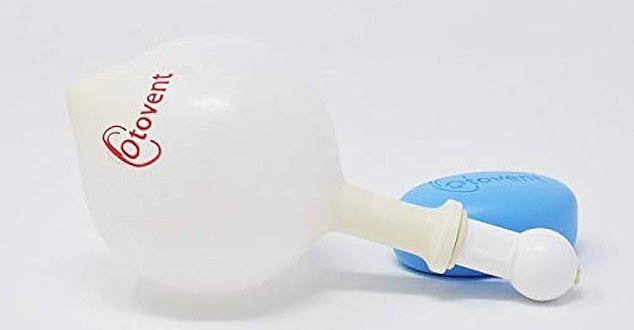Since I had an infection last year, I have suffered sporadic hearing loss in my left ear. I can sometimes overcome this by swallowing hard, but can I regain permanent hearing?
St. John Meyers, East Riding
Dr Martin Scurr answers: According to his description, this sound resembles conductive deafness, when sounds cannot pass through the ear due to a blockage in the Eustachian tube, which connects the middle ear (the part behind the eardrum) to the nasopharynx, the space at the back of the palate.
In your case, the blockage is most likely caused by mucus left over after an infection.
I would suggest trying an Otovent nasal balloon, available for around £15 from pharmacies or online, writes Dr Martin Scurr
The Eustachian tube allows air to flow into or out of the middle ear cavity, equalizing the pressure with the outside world. There is a valve at the point where the tube enters the nasopharynx, and if you have a cold, allergy, or sinus infection, you may hear a clicking or popping sound as it activates when you swallow.
Respiratory tract infections can leave residual mucus that clogs the Eustachian tube; inflammation can also continue even when the infection has cleared. As a result, the Eustachian tube and valve may malfunction for a while. Swallowing forcefully may help, allowing air to enter the middle ear.
But I would suggest you try an Otovent nasal balloon, available for about £15 from pharmacies or online. It is specifically designed to help open the Eustachian tube in patients with symptoms like yours.
First, use one or two puffs of a nasal decongestant spray (for example, Otrivine, or an equivalent, also available over the counter at your pharmacy) in each nostril.
Next, attach the nose piece attached to the balloon to one nostril, press the other nostril closed with a finger, and inflate the balloon to the size of a large orange by blowing hard with your mouth closed.
Then do the same on the other side. Repeat the process (which takes a few minutes) three times a day. I expect the blockage to be gone in a few days.
If not, you may need to be referred to an ear, nose and throat specialist for a minor operation to insert a drain (a tiny tube that allows air to pass through the eardrum).
Please note that the drains do not need to be surgically removed later, but will simply fall out on their own after about six months.
For years, I have suffered from dry, peeling skin around the tips of my fingers. No cream helps and it seems to get worse with age. I am 81 years old.
Pamela Hammond, Maidenhead.
Dr. Scurr responds: Diagnosing any skin disease without a physical exam is always difficult, but I have two thoughts on the matter.
First, it could be chronic dermatitis, an allergic response to a chemical you’ve been regularly exposed to. One possible culprit is methylchloroisothiazolinone, a preservative used in many skin care products, including shampoos and body washes, to prevent the growth of fungus and bacteria in the product.
Allergic dermatitis can occur in those who become sensitive to a chemical or ingredient, and even brief contact with it will trigger symptoms.
Wearing gloves for any activity that involves contact with detergents is the best protection.
The second possibility is that you have an atypical form of the skin condition called psoriasis. I have seen cases where the peeling is limited to the tips of the fingers, and there is a variant of psoriasis called acrodermatitis continua of Hallopeau, where pustules form on the tips of the fingers. However, this is rare and usually affects the toes as well.
Be aware of the possibility that your symptoms are due to sensitization to methylchloroisothiazolinone. It is also found in many emollients and other skin creams, so ask your pharmacy about a simple cream as a moisturizer and use skin cleansers such as Cetaphil, designed for sensitive skin.
- Write to Dr Scurr at Good Health, Daily Mail, 9 Derry Street, London W8 5HY or email drmartin@dailymail.co.uk; include your contact details. Answers should be read in a general context; please consult your GP if you have any concerns about your health.

